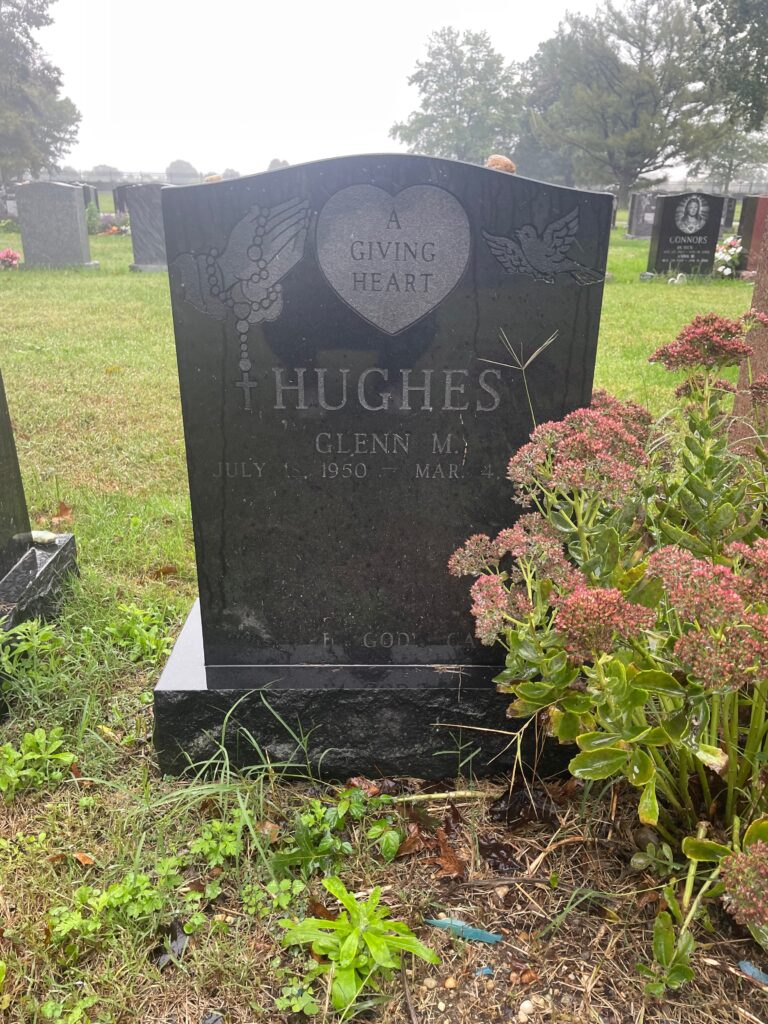Erik Visits an American Grave, Part 1,469
This is the grave of Glenn Hughes.

Born in 1950 in New York, Hughes went to a Catholic high school. In fact, he was a classmate of Bill O’Reilly. I know this because I used to know a guy who was in the same class as both of them (he said O’Reilly was a bully and asshole in high school too, I know how shocking that will be to readers this early in the morning). He graduated from high school and went to Manhattan College. Hughes was gay and of course that was a very difficult thing to be in this era. I have no idea how his family responded to this, but I can’t imagine it was very good.
In any case, Hughes became a frequenter of the city’s gay bars. He was also a huge motorcycle guy. In fact, he kept his motorcycle parked inside his house so no one would touch it. So he fit a particular type within the gay male club scene of the 1970s and he loved that scene too. He was working as a toll collector in The Bronx when his friends saw an ad for ”gay singers and dancers, very good-looking and with mustaches.” Well, that did fit Hughes. As it turned out, a French music producer named Jacques Morali had been visiting the clubs himself. He recognized the fetish themes of the gay male world at that time and so he wanted to put together an act that would represent that.
This of course became the Village People and Hughes was hired as the leather guy. This was the disco age. Much of the hatred of disco is that it was a club movement openly accepting of gay people. So for REAL MEN who listened to REAL MUSIC like Bachman Turner Overdrive, the whole disco thing was not just music they hated, it was people they hated too. No wonder the White Sox could have such a big event with its Disco Demolition Night in 1977. Disco itself is really just another form of Black popular music. It’s not my personal favorite thing, but the path is obviously from the late 60s and early 70s soul. It was that this music wasn’t just Black, it was queer.
So it certainly didn’t seem like The Village People would actually become a big thing. It was a niche band for a niche piece of American culture. Even most disco wasn’t this openly gay. But they sure did. They had a first big hit with “San Francisco (You’ve Got Me)” in 1977. That was followed by “Macho Man” in 1978. A band created as a background for the gay scene in New York quickly became a phenomenon, particularly popular with women. These openly gay songs either did not bother their fans or they just weren’t paying attention. Soon came “In the Navy,” “Go West,” and, of course, “YMCA.” The thing about “YMCA” is that the Y wasn’t just a place for gay men to hook up in the 1970s. It was used this way at least back to the 1910s, as their was a huge scandal in Portland in 1912 over middle class men having gay sex at the local Y, which was a very big story on the West Coast that year and since homosexuality was largely criminalized, some of the men involved actually had to flee to Mexico or Canada to stay out of prison. The 1970s were different than the 1910s, but the fundamentals of what the Y did in that community hadn’t changed much.
Of all the Village People members, Hughes probably got the most attention. He was a hot guy, what can you say. People included him on their 1979 Most Beautiful People List (I got screwed out of this list, even though I was only 5, but I was so cute). He appeared on Hugh Hefner’s The Playboy Mansion, a TV special promoting the Hef’s hedonistic lifestyle. The band had a movie in 1980 called Can’t Stop the Music. I don’t know it. But while Village People avoided the one-hit wonder phenomenon of the disco era, it could not escape the changing popular tastes of the 1980s and it faded into a nostalgia act soon after. But still, it’s not as if they couldn’t still play the gay clubs they were designed for anyway.
In 1996, Hughes left the Village People. He started a cabaret act, though he still helped the band out through managing at least part time.
Hughes died in 2001, at the age of 50. He was a very heavy smoker from the time he was a teenager and all the years of fame certainly didn’t suggest he should stop smoking. Lung cancer.
Let’s watch a little Village People.
Glenn Hughes is buried in Saint Charles Cemetery, Farmingdale, New York. He was buried in his leather outfit.


